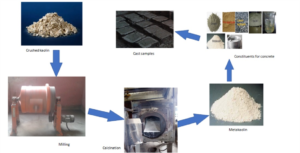While technological advancements have brought a more data-driven approach to mineral exploration, much like in petroleum geology, the art of geological intuition and judgment remains vital in many of these fields due to the inherent uncertainties and complexities of the subsurface.
Kaolin: From Intuition to Precision
Kaolin exploration has traditionally required a mix of observational skill and knowledge of regional geology. Historically, kaolin deposits were discovered through surface mapping and trenching, where geologists relied heavily on their ability to interpret soil colour and texture as indicators of underlying clay formations. These initial methods were qualitative, relying on the geologist’s deep familiarity with weathered granite and kaolinitic zones, making it very much an "art" of interpretation.
With the advent of remote sensing, geophysical surveys, and more advanced laboratory techniques for chemical analysis, kaolin exploration has become more precise. Modern technologies like satellite imaging and spectral analysis can identify clay-rich areas before boots hit the ground. However, like in petroleum geology, data can be sparse, and no two kaolin deposits are identical, especially in terms of quality, particle size distribution, and industrial usability. The decision-making process remains partly artistic, as geologists must balance raw data with field observations to estimate the economic viability of deposits. Thus, even with more sophisticated tools, judgment and experience play a crucial role, especially when considering kaolin's wide industrial applications, from ceramics to high-purity alumina (HPA).
Gold: Balancing Data and Intuition
Gold exploration has historically been a classic example of geology as an art form. Panning streams, examining rock outcrops, and interpreting geological formations have always required intuition and experience. The variability in gold deposits, whether they are placer, lode, or orogenic, means that successful gold explorers often had to "feel" their way through the subsurface clues—sometimes literally walking a prospect and relying on their gut instincts.
Modern exploration techniques, such as geophysics (magnetics, gravity surveys), geochemistry (stream sediment sampling, soil assays), and drilling campaigns, have added layers of scientific rigor to the search for gold. Probabilistic modelling, data integration, and resource estimation techniques (e.g., block models) have brought a more scientific methodology to the forefront. Yet, uncertainty still looms large. Even today, no matter how much data is processed, the decision to drill a certain anomaly or extend exploration in a particular direction often hinges on a mix of both art and science. The diverse forms gold can take in the earth—whether finely disseminated in pyrite or concentrated in quartz veins—require flexible interpretation that balances data with the geologist’s accumulated experience.
Rare Earth Elements (REEs): A Complex Exploration
Rare earth elements, vital for high-tech industries like electronics, renewable energy, and defence, represent a frontier where science has advanced exploration methodologies considerably, but where uncertainties and the art of geological judgment remain key. The distribution of REEs in the Earth's crust is typically associated with specific geological settings, such as carbonatites, alkaline rocks, and lateritic clays. Identifying these settings initially relied on the expertise of geologists familiar with the unique environments where REEs might accumulate.
Today, advanced geochemical assays, hyperspectral imaging, and detailed mineralogical studies can pinpoint REE concentrations with more precision. Nonetheless, the economic extraction of REEs often depends not just on grade, but on the mineralogical form and processing methods. As with gold and kaolin, REE deposits are geologically diverse, with each deposit requiring tailored metallurgical approaches for economic viability. The variability of REE distributions and market demands for specific elements (e.g., neodymium, praseodymium) mean that judgment calls are essential in every stage of exploration and development. The art of REE exploration lies in predicting how geology, metallurgy, and market trends will align for long-term success.
Industrial Minerals: Navigating Diverse Market Needs
For industrial minerals such as silica, graphite, and limestone, the shift from art to science is equally apparent. Historically, surface outcrops and simple mapping sufficed for locating large deposits of these materials. Geologists relied on visual cues and surface sampling to assess the potential of a deposit. Industrial mineral exploration traditionally valued practical knowledge—knowing the local geology, understanding mineral quality requirements for specific industries (e.g., glassmaking, ceramics), and using basic beneficiation techniques to demonstrate usability.
However, in today’s market-driven environment, exploration has become much more scientific. Demand for industrial minerals with precise specifications (e.g., high-purity quartz for solar panels, or specific grades of graphite for battery anodes) means that exploration now involves rigorous chemical assays, 3D geological modelling, and high-resolution geophysical surveys. The mineral's end-use dictates the exploration methods and the criteria for assessing deposits. Yet, even with all the data at hand, the art of judgment persists. Geologists must determine not just the geological potential of a deposit, but also its economic viability, considering market trends, processing costs, and logistical challenges.
A Persistent Need for Integration and Judgment
In all these cases—whether kaolin, gold, REEs, or industrial minerals—the role of the geologist as an integrator remains vital. Data from various sub-disciplines (structural geology, geophysics, geochemistry) must be synthesized into a coherent understanding of a prospect. While software and models can produce increasingly refined estimates, the human element in exploration geology still plays a crucial role. Geological variability, economic factors, and market unpredictability all add layers of complexity that cannot be fully captured by even the most advanced quantitative models.
The art of geology persists in making judgments about where to drill, how to model subsurface formations, and when to advance or abandon a prospect. Experienced geologists can recognize subtle geological patterns and anomalies that data-driven methods might overlook. They weigh conflicting data sets, reconcile different interpretations, and make the final call on whether a mineral prospect has the potential to become a viable mine.
The Future of Mineral Exploration: Balancing Science and Art
As exploration technologies continue to advance, with the rise of AI-driven predictive models, machine learning, and enhanced data integration, the science of mineral exploration will undoubtedly grow more precise. However, the role of the geologist as both a scientist and an artist will not diminish. The diversity of the Earth’s geology, coupled with economic and market complexities, ensures that exploration will always require both technical expertise and intuitive judgment.
Ultimately, whether exploring for kaolin, gold, REEs, or industrial minerals, the best geologists are those who can effectively blend the science of geology with the art of interpretation. The industry's future will likely see a continued balancing act between these two forces, as exploration pushes into more complex terrains, deeper deposits, and new resource demands.
Thus, while modern exploration may feel more like a science, the art of geology still holds a critical place in the quest for the Earth's hidden treasures.



